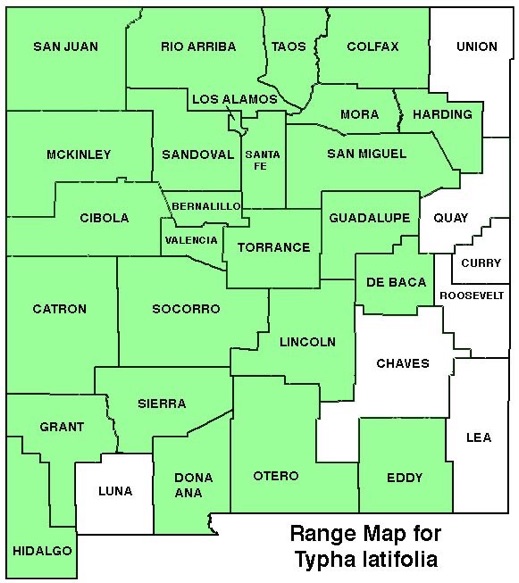WILDFLOWERS OF NEW MEXICO

Unbranched, pithy stems reach 5–10 feet tall in shallow waters and wet soils. Note the long, narrow, light-green leaves that sheath the stem, and the brown, cylindrical flower clusters on the stem tips that age and disintegrate into a mass of fluffy seeds that disperse in the wind. Spreading by rhizomes, cattails can form dense colonies in shallow water and saturated soils.
FLOWER: May–September. Stems are tipped with separate male and female spikes with hundreds of tiny flowers without petals or sepals, and densely packed together. At the tip of stem end, the spike of brown male flowers with abundant yellow pollen forms a narrow cylinder 2 3/8 inches long (1–12 cm). The female spike, 4–7 inches long (10–18 cm), begins immediately below the male spike leaving no exposed stem between them. The spike matures as a reddish-brown, cigar-like cluster with fluffy seeds that spread in the wind.
LEAVES: Alternate, 12–16 per stem. Blades light-green, nearly flat, thick, spongy, 3/8–1 inch wide (10–23 mm), and about as long as the stem; leaf bases sheath the stem.
HABITAT: Wet soils of shallow, slow-moving water, ditches, lake sides, marshes, backwaters, meadows, fens, wetlands, canyons; aquatic, semi-aquatic, riparian zones from desert springs to montane meadows.
ELEVATION: 3,750–9,200 feet.
RANGE: Throughout North America.
SIMILAR SPECIES: The less common look-alike Narrow-leaf Cattail, T. domingensis, has narrower 1/2 inch wide leaves with a slightly curved cross section, and minute floral differences, but most noticeably the male flower spike is distinctly separated by 3/8–1 1/2 inches of bare stem above the female spike. The introduced and widespread Dwarf Cattail, T. angustifolia, in eastern and the southern half of NM, is nearly indistinguishable from Narrow-leaf Cattail.
NM COUNTIES: Nearly statewide (absent eastern plains) in low- to high-elevation wet to aquatic habitats: Bernalillo, Catron, Cibola, Colfax, De Baca, Dona Anna, Eddy, Grant, Guadalupe, Harding, Hidalgo, Lincoln, Los Alamos, McKinley, Mora, Otero, Rio Arriba, San Juan, San Miguel, Sandoval, Santa Fe, Sierra, Socorro, Taos, Torrance, Valencia.
NOTES: Cattails have been a “supermarket” plant for native peoples around the world for over 10,000 years. The roots contain as much protein as corn and rice and more starch than potatoes. The young stalks, flowers, and protein-rich pollen and seeds were also eaten; the leaves used for baskets, mats, sandals, and thatching; the fiber woven into textiles and cordage; and the absorbent seed fluff used in pillows, mattresses, and diapers. Plus the versatile plant has many medicinal and religious ceremonial uses.

BROAD-LEAF CATTAIL
TYPHA LATIFOLIA
Cattail Family, Typhaceae
Perennial herb


THE CONTENTS OF THIS WEBSITE ARE COPYRIGHTED AND CANNOT BE USED
WITHOUT PERMISSION OF GEORGE OXFORD MILLER
EMAIL ME

The male flower spike is at the top of the stem (top arrow), and the female spike below (bottom arrow), with no bare stem between the two (middle arrow).




Cattail seeds have a fluffy mass spread by the wind.
Broad-leaf Cattail leaves reach 1 inch wide and had many traditional uses.
Cattails form dense colonies in wet soils and shallow water.
(Photos: Rio Grande oxbow, Albuquerque)
